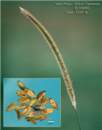Scientific name(s)
Setaria sphacelata
Strengths
- Palatable
- Establishes easily from seed
- Persists under moderate grazing
- Adapted to a wide range of soils
- Responds well to fertiliser nitrogen
- Tolerant of flooding and waterlogging
- Some lines frost tolerant
- High forage production early spring, summer and autumn
- Competes well with fireweed
- Although little growth occurs in winter, green leaf carries well into winter
Limitations
- High levels of oxalate in some varieties can cause problems with milking cows, horses and donkeys
- Quality drops rapidly with onset of seeding
Plant description
Plant: Tufted perennial grass growing 1 - 2m tall, and up to about 30cm diameter at the base.
Stems: Smooth and shiny, sometimes slightly waxy.
Leaves: Young shoots are flattened at the base, and the leaves folded (not rolled). Leaves are generally hairless, soft to the touch and bluish grey-green in colour, often reddish around the stem; leaf blades to 50 cm long and over 1 cm wide.
Seedhead: Seeds are borne on a bristly, cylindrical "spike" 6 - 25cm long, and about 1cm across, varying in colour from golden to dark brown.
Seeds: Very small, averaging about 1.5 million/kg
Pasture type and use
Good for intensively grazed permanent pastures in the humid subtropics, and upland and southern tropics, as well as for hay production.
Where it grows
Rainfall
Setaria is mostly sown in areas receiving an average annual rainfall of over 1,000 mm, and is well-suited to irrigation.
Soils
It grows well on most soils providing moisture and fertility are adequate. It is not well adapted to alkaline, very acid, or saline soils.
Temperature
See "Cultivars"
Establishment
Companion species
Grasses: normally not sown with other grasses
Legumes:
- twining: glycine, siratro
- trailing: Greenleaf and Silverleaf desmodium
- creeping: Maku lotus, pinto peanut, Shaw vigna, white clover
Setaria competes strongly with companion species for plant nutrients in less fertile soils, and may suppress them in the absence of added fertiliser.
Sowing/planting rates as single species
2 - 4 kg/ha for nitrogen-fertilised grass
Sowing/planting rates in mixtures
1 - 2 kg/ha, the lower rate for creeping legumes.
Sowing time
It can be sown successfully from spring to early autumn. As a general rule, it is best to choose a suitable sowing time for any associated legume.
Inoculation
Not applicable
Fertiliser
Because it grows best in at least moderately fertile soils, it is advisable to use an establishment application of say 200 - 300 kg/ha of superphosphate and 50 kg/ha of muriate of potash on less fertile soils. A post-emergence application of 100 kg/ha of urea (= 46 kg/ha N) is beneficial in pure stands.
Management
Maintenance fertliser
Annual dressings of up to 200 kg/ha of superphosphate and 100 kg/ha of muriate of potash (depending on soil fertility), are required to maintain high production levels. In pure stands, where high levels of fertiliser nitrogen are used (e.g. up to 300 kg/ha of nitrogen in three split applications), occasional dressings of lime may also be necessary to overcome increasing soil acidity.
Grazing/cutting
Although it is fairly tolerant of mowing or grazing, it will give way to creeping grasses such as blue couch or mat grass if grazed heavily over a prolonged period. Setaria decline is more rapid if nitrogen fertility is low.
Seed production
Seed is produced over much of the growing season, with good commercial yields usually of the order of 100 kg/ha. Seed crops are fertilised with 100 - 150 kg/ha of N/ after a cleaning cut ha, and are usually direct headed when 10 - 15 per cent of the seed has shattered.
Ability to spread
Setaria spreads effectively by seed, and readily colonises disturbed areas such as roadsides.
Weed potential
Although listed as a weed in some regions, it rarely invades undisturbed areas.
Major pests
Severe attack by armyworm and pasture webworm can destroy much of the leaf, particularly young leaf. Buffel grass seed caterpillar can cause considerable damage to seed crops from late January onwards.
Major diseases
Pyricularia leaf spot is prevalent under hot humid conditions and can retard the growth of ungrazed stands.
Herbicide susceptibility
Setaria is susceptible to glyphosate.
Animal production
Feeding value
Protein content of the grass depends on nitrogen fertility of the soil, and age of regrowth of the stand (best if less than 4 weeks' regrowth). Young leafy regrowth (3 weeks) can have digestible dry matter levels of 70%, but after 6 - 8 weeks, digestibility levels drop to 50 - 55%. Sodium levels are often low requiring supplementation in the diet. See "livestock disorders/toxicity"
Palatability
Setaria is extremely palatable when young, but becomes stemmy and unacceptable with onset of seeding.
Production potential
Livestock disorders/toxicity
Setaria develops high levels of oxalate in the leaf, especially in young, well-fertilised, vigorous growth. This causes hyperparathyroidism ('big head' disease) in horses and donkeys, and can cause nephrosis (kidney disease) in ruminants. It can also lead to hypocalcaemia (milk fever) and/or hypomagnesemia (grass tetany) in ruminants, particularly in high-producing dairy cows. This is less of a problem in animals that graze setaria regularly. 'Kazungula' and 'Splenda' develop the highest oxalate levels, followed by, 'Narok' and 'Solander', with 'Nandi' the lowest.
Cultivars
| Cultivar | Seed source/Information |
| Kazungula | Australian Herbage Plant Cultivars |
| Nandi | Australian Herbage Plant Cultivars |
| Narok | Australian Herbage Plant Cultivars |
| Solander | Australian Herbage Plant Cultivars |
| Splenda | Australian Herbage Plant Cultivars |
Further information
Tropical Forages database (SoFT) - SetariaNSW Deprtment of Primary Industries - Setaria Agnote DPI-293
Acknowledgements
Mr Bede Clarke, NSW DPI, Casino
Author and date
Bruce G. Cook
August 2007





